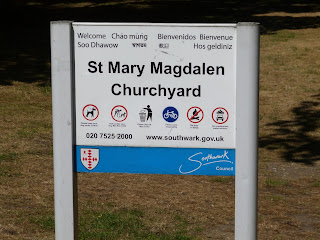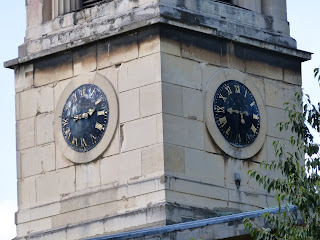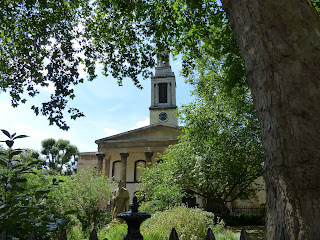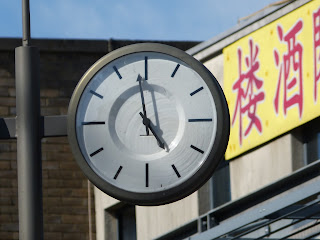Two of the churches were familiar to me from previous visits to the White Cube and other forays south of the river (apparently the ancient bye law, much quoted by London cabbies, of not travelling south of the river does not apply during daylight hours). The third one was found on a serendipitous diversion.
The first of the trio (or I suppose I should call it a trinity) is opposite Borough tube station. This is St George the Martyr.
The church dates from 1736, but is now dominated by much more modern architecture. And in particular the Shard, which can be seen as a backdrop to all three churches in this survey.
There are subtle difference in the clock faces on the southern and western aspects. Both are similar in size, colour and the use or a decorated surround.
The difference is in the design of the numerals and the hands, both of which are more decorative on the southern face....
....than they are on the western face.

The walk to the White Cube takes you along Long Lane and then left into Bermondsey Street, where you immediately come upon church number two - St Mary Magdalen.
This is more hemmed in than St Georges, and has two identical clock faces visible to those going up and down Bermondsey Street. The adjacent churchyard is now a haven of a small park, from where you can see the shard rising up again in the distance.
There has been a church on the site since 1290, but the present building dates from 1690 with additions in 1705 and 1794, and major alterations in 1830.
The clock, by the way, is not currently working.
To vary my trip, I walked back to Borough station via Great Dover Street. About halfway along, there is a divergent road called Trinity Street - could that be trinity as in Holy Trinity church, and hence the possibility of a clock? Only one way to find out of course.
To which I was rewarded with a very British / London sight - a square enclosed with railings, with nearby traditional red post box and telephone box. The big difference from most other London squares is that this one has a big church sitting in the middle of it. I really wasn't expecting to find this scene.
And hurrah, the church has a clock.
The church is, of course, Holy Trinity, and the square is Trinity Church Square.
Holy Trinity dates from 1824.
Oh look, there's the Shard in the background:
The hands on the main façade are not in a good a condition as they should be.

































































